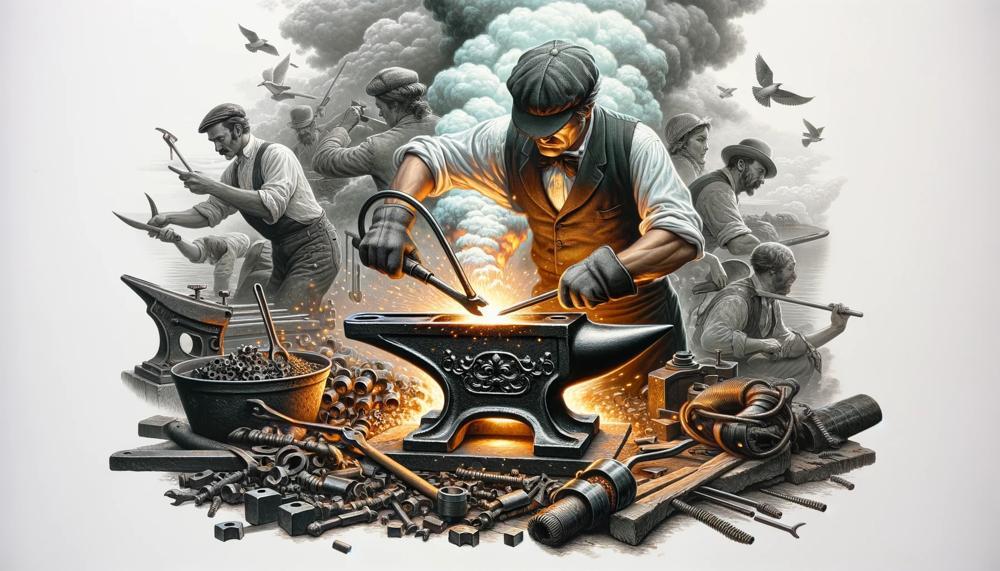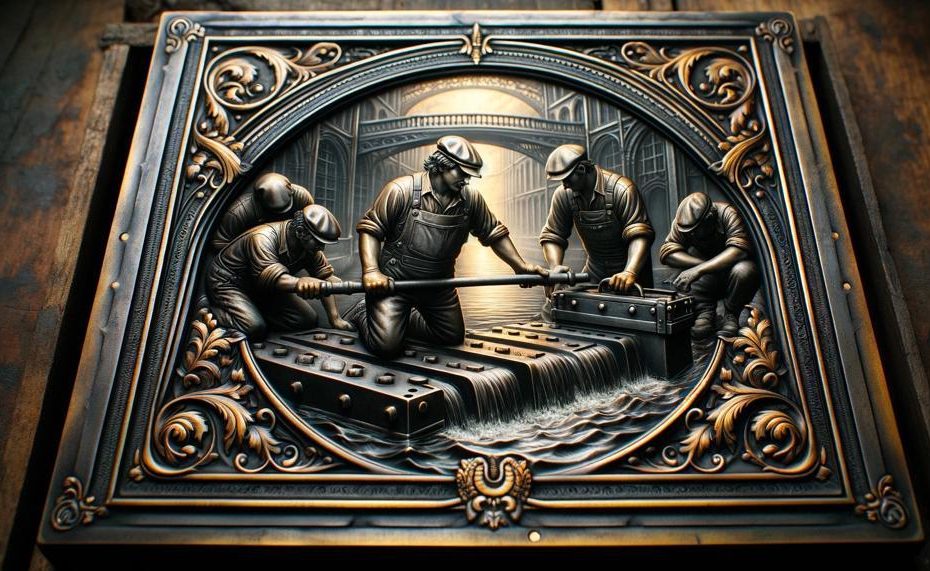As you get better at do-it-yourself projects and crafting, you’ll find that repairing cast iron without welding is an interesting and useful skill. The ability to fix things not only keeps them useful, but also keeps the emotional value of things like a yard bench that has a story behind it.
In this blog post, we’ll talk about the most important ways to fix cast iron items without putting them back together. You can learn how to use metal stitching and cold welding materials, as well as epoxy fills. We’ll walk you through each method clearly and easily.
So, how to fix cast iron without welding?
No need to weld to fix cast iron in these ways:
- The cold weld paste: Metal epoxy putty is another name for this heat-resistant glue that can join cast iron to metals like aluminum, PVC, zinc, and stainless steel. Mix the hardener and resin of the epoxy in equal parts, and then use a putty knife, spoon, or dowel stick to spread the glue.
- Glue with steel fibers: This is good for cast iron and is also known as “liquid weld.” Just like J-B Weld Welding without heat One ounce of epoxy and one ounce of hardener make up Steel Reinforced Epoxy with Hardener.
- Use Lock-N-Stitch: This other way to fix it involves putting a number of connecting pins along the crack. As the pins get tighter, they pull the broken piece of cast iron in.
- Stitching without heat: This method involves drilling a design of holes that fit together and then hammering in a pre-made plug.
Putting cooking oil or bacon grease on rusty cast iron is another way to fix it.
Embark on this journey with us, and discover how to reclaim the durability and beauty of your cast iron pieces, all without the sparks and heat of welding.
Contents
- 1 The Benefits Of Fixing Cast Iron Without Welding
- 2 Tools And Materials You Need
- 3 Step-By-Step Guide To Fixing Cast Iron Without Welding
- 4 Tips And Tricks For A Successful Repair
- 5 Precautions To Take When Fixing Cast Iron
- 6 Alternative Methods For Fixing Cast Iron
- 7 Pros And Cons Of Alternative Methods
- 8 Maintaining And Caring For Repaired Cast Iron
- 9 Conclusion
The Benefits Of Fixing Cast Iron Without Welding
Repairing cast iron without resorting to welding techniques offers numerous advantages, providing a viable, effective solution for restoration efforts. This approach not only maintains the integrity and appearance of the cast iron piece but also offers practical benefits in terms of cost, convenience, and long-term maintenance.
| Benefit | Description | Relevance |
| Cost-Effectiveness | Non-welding repairs, such as using epoxy, are more budget-friendly as they do not require expensive welding equipment or professional welders. | Reduces repair costs significantly, making it accessible for more people. |
| Convenience | These methods require minimal tools and effort, making them ideal for DIY enthusiasts or those without access to welding equipment. | Makes it easier for individuals to undertake repairs themselves, without needing specialized knowledge or tools. |
| Preservation of Original Look | Non-welding techniques maintain the original aesthetic of the cast iron, crucial for antiques or decorative items. | Important for maintaining value and appearance, especially in vintage or heirloom pieces. |
| Future Maintenance | Repairs made without welding are easier to adjust, modify, or redo, allowing for simpler future maintenance. | Facilitates ongoing care and prolongs the life of the item. |
| Material Integrity | Welding can sometimes lead to warping or further cracking due to the high heat involved. Non-welding repairs avoid this risk. | Ensures the structural integrity of the cast iron piece is maintained or enhanced. |
| Versatility | Methods like epoxy putty and brazing can be used on a wide range of damages, from small cracks to larger breaks. | Offers a solution for various levels of damage without the limitations of welding. |
| Safety | Non-welding methods generally pose fewer safety risks compared to welding, which requires dealing with extreme heat and potentially harmful fumes. | Reduces risk of injury for the person performing the repair. |
By choosing non-welding repair methods, individuals can enjoy these significant advantages, ensuring that their cast iron items are not only restored to their former glory but also maintained in a manner that is both practical and aesthetically pleasing.
Tools And Materials You Need
Repairing cast iron without the necessity of welding is both an art and a craft, blending patience with precision. To mend your cherished cast iron pieces without melting them down and starting afresh, you’ll need a toolkit that’s as robust as the material itself.
| Material/Tool | Usage | Why It’s Needed |
| Epoxy adhesive (high temperature) | Bonding | Acts as a substitute for welding, offering a strong bond that withstands high temperatures. |
| Wire brush or sandpaper | Surface preparation | Removes rust and creates a clean surface for the epoxy to adhere to. |
| Steel wool | Smoothing | Finishes the surface preparation by smoothing out any roughness left by the wire brush or sandpaper. |
| Heat-resistant coating | Protection | Guards the repaired area against high temperatures, preserving the repair work. |
| Paint (suitable for cast iron surfaces) | Aesthetic | Restores the original appearance, blending the repair into the rest of the item. |
| Protective sealant (optional) | Sealing | Offers an additional layer of protection, especially for outdoor items. |
| Gloves and eye protection | Safety | Ensures you don’t get nicks, cuts, or irritations from handling rough materials or chemicals. |
| Proper ventilation | Safety | Prevents inhalation of potentially harmful fumes from adhesives and paints. |
Step-By-Step Guide To Fixing Cast Iron Without Welding
Repairing cast iron without welding involves a strategic approach, using materials specifically suited for the task to ensure durability and strength. Below is a detailed step-by-step guide along with the materials required for this process:
Step-by-Step Guide:
| Step | Description | Key Points |
| Alternative Methods | Identify suitable non-welding techniques. | Assess damage to choose the correct method. |
| Material Gathering | Collect necessary items for repair. | Epoxy, brazing materials, metal rods, etc. |
| Surface Preparation | Clean and prep the cast iron surface. | Ensure area is free from dirt and grease. |
| Epoxy Putty Application | Apply epoxy putty for minor cracks. | Create a strong bond on small damages. |
| JB Weld for Larger Repairs | Use JB Weld for substantial fixes. | Provides a reliable bond on clean surfaces. |
| Fusion-bonded Coatings | Apply epoxy coatings for corrosion protection. | Use thermosetting powders for durability. |
| Cold Metal Stitching | Reinforce area with metal rods or pins. | Effective for larger cracks and breaks. |
| Brazing | Melt filler metal into cracks. | Suitable for high-stress areas needing strong bonds. |
| Heat-free Brazing | Use low-temp brazing alloys for simpler repairs. | An accessible alternative requiring less expertise. |
| Metal Stitching with Locks | Implement metal locks or keys for severe cracks. | Bridges cracks to prevent further damage. |
| Reinforcing with Steel Plates | Add steel plates for extra support under heavy loads. | Enhances strength and stability. |
| Following Specific Instructions | Adhere to the guidelines for each repair method. | Ensures optimal outcomes and durability. |
| Preventative Maintenance | Engage in regular care to avoid future damage. | Extends lifespan and maintains functionality. |
Materials Needed:
- Epoxy putty: Versatile adhesive for bonding cast iron surfaces.
- JB Weld: High-strength adhesive suitable for larger repairs.
- Fusion-bonded epoxy coatings: Protect against corrosion and enhance durability.
- Metal rods or pins: Strengthen the structure in cold metal stitching.
- Brazing material: Filler metal for bonding pieces together.
- Low-temperature brazing alloys: Simplify the brazing process without high heat.
- Metal locks or keys: Secure the crack using a locking mechanism.
- Steel plates: Provide additional support for heavy load-bearing areas.
The materials and methods selected will depend on the specific type and extent of the damage. Each technique requires careful attention to detail and adherence to the recommended procedures to ensure a successful repair.
Tips And Tricks For A Successful Repair
For a successful repair of cast iron without welding, embracing specific methods and materials is key. Here’s a guide, broken down into easily digestible tips, aimed at ensuring your cast iron items are fixed up, good as new, without the need for intense heat or a welder’s touch.
Choose the Right Epoxy Adhesive
The foundation of a good non-weld repair is selecting an epoxy designed to withstand high temperatures and bond well with cast iron.
| Product Selection | Key Features | Application Tips |
| Epoxy Adhesive for High Temperatures | Formulated to endure the rigors of heat, ensuring durability | Apply in a well-ventilated area, wearing protective gloves and eyewear |
| Epoxy Putty | Easy to mold and shape for precise repairs | Layer thinly for better adhesion and a flawless finish |
Preparation Is Paramount
A clean surface is non-negotiable. Use a wire brush or sandpaper to thoroughly clean the area, ensuring the epoxy has a clean, rough surface to adhere to.
Patience in Curing
After application, allowing the epoxy to cure fully, as per the manufacturer’s instructions, is crucial for a bond that lasts.
Sand for a Seamless Finish
Once the repair is solid, sanding it down ensures the fix is not only strong but also visually appealing.
Protection and Aesthetics
Select a paint compatible with both cast iron and the epoxy used. This not only enhances the look but also adds an extra layer of protection.
Seal the Deal
For high-temperature areas, consider a heat-resistant sealant over the repair. This step ensures the durability of your fix.
Safety First
Always work in a well-ventilated space and use protective gear. Follow the product instructions to the letter, taking breaks if needed.
Test Before Full Use
Before putting your repaired item back to heavy use, test it under lighter conditions to ensure the repair holds.
By following these steps, you can effectively repair cast iron items without welding, ensuring longevity and durability.
Precautions To Take When Fixing Cast Iron
When fixing cast iron without welding, it’s paramount to take certain precautions to ensure the repair is successful and durable. Here’s a simplified guide to navigating this task, focusing on the importance of preparation, choosing the right materials, and post-repair care.
| Step | Action | Reason |
| Preparation | Clean thoroughly using a self-cleaning oven | Ensures clean surface for adhesive bonding |
| Material Selection | Choose high-temperature resistant epoxy | Ensures durable bond suitable for cast iron |
| Safety | Wear protective gear | Prevents harm from fumes/splatters |
| Patience in Curing | Allow adequate curing time | Ensures strong bond formation |
| Finishing | Sand for a smooth finish | Enhances repair strength and appearance |
| Protection | Apply heat-resistant sealant and optional paint | Shields repair from elements and rust |
| Testing | Conduct tests before heavy use | Confirms repair integrity under stress |
Alternative Methods For Fixing Cast Iron
Cast iron items are tough but when they break, welding isn’t always the go-to fix due to its complexity and the high heat involved, which could lead to further damage.
There are several effective alternative repair techniques that keep your cast iron intact without the sparks. Let’s take a gander:
| Method | Description | Best Used For |
| Epoxy Putty | A mouldable adhesive that hardens to seal cracks and breaks. | Minor cracks and cosmetic issues. |
| Cold Metal Stitching | Securing the crack with metal rods or pins without applying heat. | Larger, structural cracks. |
| Brazing | Using a filler metal at lower temperatures than welding to join broken pieces. | Creating a strong, heat-resistant bond. |
| Fusion-Bonded Epoxy Coatings | Applying a protective and sealing coat over damaged areas. | Corroded or weathered surfaces. |
| Metal Stitching with Locking Keys | Repairing cracks with specialised keys to lock the pieces together. | Cracked engine blocks or heavy machinery. |
| Reinforcement with Steel Plates | Attaching steel plates to strengthen or stabilize the area. | Heavily loaded or stressed parts. |
| Mechanical Fastening | Using screws, bolts, or other fasteners to hold pieces together. | Simple breaks where alignment is not an issue. |
Remember, fixing cast iron without welding ain’t just about sticking pieces back together. It demands patience, the right materials, and a bit of elbow grease. Whether it’s a cherished skillet or a vintage bench leg, the right approach will breathe new life into your ironed friends, keeping them out of the scrap heap for another day. Each method has its place, based on the type of damage and the item’s importance.
Pros And Cons Of Alternative Methods
| Method | Pros | Cons |
| Epoxy Putty | Cost-effective and doesn’t demand sophisticated tools; splendid for minor, surface-level repairs. It maintains the cast iron’s original facade, making it a go-to for items where aesthetics are key. | Its endurance under heavy stress or high temperatures may not rival that of welded repairs. It’s paramount to match the epoxy’s properties with the cast iron’s use to avoid premature failure. |
| Cold Metal Stitching | Ideal for complex fractures, it fortifies the integrity of the material without the need for intense heat, thus preserving the original characteristics of the cast iron. | Requires a skilled hand and a keen eye for detail; not every workshop has the know-how. Depending on the complexity, it can be more costly than other methods. |
| Brazing | Allows for a robust bond with less thermal distortion than traditional welding, offering a solution that’s both strong and aesthetically pleasing for decorative items. | Brazing material must be chosen with care to ensure compatibility with cast iron, and the method can be less forgiving if not executed with precision. |
When one deliberates on fixing cast iron, it’s not just about choosing a technique; it’s about balancing act between cost, convenience, and continuity. Alternative methods like epoxy putty, cold metal stitching, and brazing present a palette of options beyond traditional welding, each with its own merits and challenges.
Maintaining And Caring For Repaired Cast Iron
To keep your mended cast iron in prime condition and avoid the need for further repairs, here’s a straightforward guide. Remember, it’s not just about fixing; it’s about cherishing and maintaining what you’ve restored.
Season with Care
First off, seasoning isn’t just a one-time affair. It’s the shield that guards your pan against wear and tear. Use a smidgen of oil, heat it well, and let the magic happen.

This creates a non-stick surface and prevents rust.
Cleaning Rituals
Don’t let food remnants linger. Clean your pan right after use, but skip the soap and hard scrubbers; they’re foes to the seasoning.
Warm water and a soft brush should be your go-tos. If it’s sticky, it’s a sign; re-season.
Generosity with Fat
Some dishes are clingy by nature. When cooking such, don’t skimp on the butter or oil. It’s better to err on the side of generosity here.
It protects the pan and makes your food tastier.
Avoid Overheating
Patience is a virtue, especially with cast iron. High heat for too long is a no-go. It risks food sticking and damaging the pan.
Low and slow often wins the race.
Season, Then Season Some More
Even if your pan claims to be pre-seasoned, give it some love and additional seasoning. Regular upkeep will keep it at its non-stick best.
Smart Storage
Rust is the enemy. Store your pans in a dry place where they don’t play bumper cars. Space them out; they appreciate a little breathing room.
Choose Wisely What to Cook
Delicate foods and acidic adventures can be tough on your pan’s seasoning. If you venture there, know that a re-season might be soon after.
Water Is Not a Friend
Leaving your pan soaking is inviting trouble. Dry it thoroughly post-wash, and if you can, give it a quick heat on the stove to banish any lurking moisture.
| Step | Action | Why |
| 1 | Season properly | Creates a protective, non-stick layer. |
| 2 | Clean gently but promptly | Avoids damage and maintains seasoning. |
| 3 | Use enough fat | Prevents sticking and enhances flavor. |
| 4 | Avoid overheating | Protects the pan and its seasoning. |
| 5 | Regular re-seasoning | Keeps the non-stick surface in good condition. |
| 6 | Invest in proper storage | Prevents rust and damage from contact. |
| 7 | Be selective with cooking choices | Acidic foods and delicate dishes can damage seasoning. |
| 8 | Avoid soaking | Prevents rust and seasoning loss. |
Following this regimen will not only maintain your cast iron’s condition but also enhance its legacy, as each meal adds to its story. Keep it seasoned, clean it with care, and cook with wisdom.
Conclusion
It is an art form to bring back the power and beauty of cast iron objects without using the high heat of welding. It combines old-world skill with modern creativity.
We can keep the stories and usefulness of our beloved cast iron pieces alive by carefully using metal stitching, cold welding chemicals, and epoxy fills. This method of restoration not only saves money and keeps the item’s original look, but it also gives the person doing the repair a sense of accomplishment.
Fixing cast iron without soldering is a trip that shows how strong the material is and how skilled the person who is fixing it can be. With the right method, even the smallest fixes can be made to last.





